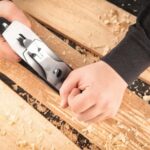What does ripping mean in woodwork? In the world of woodworking, understanding the different techniques and terminology is essential for mastering the craft. One such term that often comes up is “ripping,” which plays a crucial role in many woodworking projects. Whether you’re a beginner or an experienced woodworker, having a solid grasp of what ripping means and how it’s done can greatly improve the quality of your work.
Woodworking involves using various tools and techniques to shape and manipulate wood into desired structures and designs. Understanding the basics of working with wood is foundational to developing advanced skills and creating intricate pieces. Ripping, in particular, is a fundamental technique that every woodworker should be familiar with as it serves as the building block for numerous projects.
In this article, we will explore the concept of ripping in woodwork, including its definition and purpose. We will also delve into the tools and equipment needed for ripping, safety precautions to keep in mind, as well as a step-by-step guide to effectively rip wood.
Additionally, we will discuss common mistakes to avoid, advantages and disadvantages of ripping, and provide examples of ripped wood projects. By the end of this article, you’ll have a comprehensive understanding of the importance of mastering ripping in woodwork.
What Is Ripping in Woodwork
Ripping in woodwork refers to the process of cutting a piece of wood along its length, with the grain. This is usually done to make the wood narrower or to create strips of wood with a consistent width. Ripping is an essential skill in woodworking and is used in a wide variety of projects, from building furniture to creating decorative pieces.
The purpose of ripping in woodwork is to create straight, parallel edges on a piece of wood. This can be done using a table saw, circular saw, or hand saw, depending on the size and type of wood being ripped. Ripping also allows woodworkers to control the thickness and width of the boards they are working with, giving them more flexibility in their designs and projects.
When it comes to tools and equipment needed for ripping, there are several options available depending on the scale of the project and personal preferences. Some common tools include:
- Table saw
- Circular saw
- Hand saw
- Rip fence
- Push stick
Each tool has its own set of advantages and disadvantages, so it’s important to choose the right tool for the specific job at hand. Additionally, safety precautions should always be taken when ripping wood to avoid accidents and injuries. This includes wearing appropriate safety gear such as goggles and hearing protection, as well as following proper procedures for using each type of equipment.
Overall, understanding what does ripping mean in woodwork and mastering this technique is crucial for any woodworker looking to pursue projects that involve creating straight-edged pieces or customizing board sizes. Whether working on small crafts or large-scale constructions, knowing how to properly rip wood will significantly enhance one’s woodworking skills and capabilities.
Tools and Equipment Needed for Ripping
A fundamental aspect of woodworking is having the right tools and equipment for each specific task. When it comes to ripping wood, there are a few essential tools that you will need to ensure a successful and efficient process.
The primary tool for ripping wood is the table saw, which is specially designed for making straight cuts along the length of a board or panel. In addition to a table saw, you will also need a rip fence, which acts as a guide to keep the wood straight while it passes through the blade.
Another important piece of equipment for ripping wood is a push stick or push block, which helps to safely maneuver the wood through the saw without putting your hands at risk of injury. Additionally, having a measuring tape and pencil on hand can help ensure that you make accurate and precise cuts during the ripping process. It’s also important to have hearing protection, eye protection, and appropriate work gloves when operating any woodworking machinery.
In some cases, if you don’t have access to a table saw, you can use a handheld circular saw with a rip-cut guide attachment to achieve similar results. However, using a table saw is generally preferred for ripping wood due to its accuracy and stability.
Regardless of the specific tools you use, it’s crucial to ensure that they are in good working condition and properly maintained to guarantee safe and effective operation. Understanding what does ripping mean in woodwork involves having the necessary tools and equipment on hand to carry out this woodworking technique effectively.
Safety Precautions When Ripping Wood
Woodworking can be a rewarding and fulfilling hobby or profession, but it is important to always prioritize safety when working with wood. Ripping, in woodwork, refers to cutting along the length of the grain of the wood, and it is crucial to take certain safety precautions to avoid accidents and injuries.
Protective Gear
When ripping wood, it is essential to wear the appropriate protective gear. This includes safety goggles to protect your eyes from flying wood chips, a dust mask to prevent inhalation of sawdust, and ear protection if you are working with loud power tools. Additionally, wearing gloves can help protect your hands from splinters and cuts.
Stable Work Surface
Ensure that your work surface is stable and secure before you start ripping wood. Unstable workbenches or sawhorses can pose a serious risk of accidents. It is also important to keep your work area clean and free of clutter to avoid tripping hazards.
Proper Use of Tools
Using the right tools for ripping wood is vital for safety. Make sure that your table saw or handheld circular saw is in good working condition, and always follow the manufacturer’s instructions for operating the equipment. Keep your fingers well away from the path of the blade and never force the wood through the saw.
By following these safety precautions when ripping wood, you can minimize the risk of accidents and create a safe woodworking environment for yourself. Remember that prioritizing safety is essential in any woodworking project, no matter how experienced you may be.
Step-by-Step Guide to Ripping Wood
Ripping wood is a fundamental skill in woodworking that involves cutting a piece of wood lengthwise, parallel to the grain. This process is commonly used to create narrower boards or to remove irregular edges. In this section, we will provide a step-by-step guide to ripping wood, including the necessary tools, techniques, and precautions.
Preparation and Planning
Before beginning the ripping process, it is important to carefully plan and measure the wood to ensure accuracy and precision in the cuts. Start by marking the cutting line using a pencil and a straight edge. It’s essential to measure twice and cut once to avoid any errors.
Choosing the Right Saw
The most common tool used for ripping wood is a table saw equipped with a rip fence. The rip fence helps guide the wood through the saw blade at a consistent width. However, if a table saw is not available, a handheld circular saw with an edge guide can also be used for ripping.
Executing the Rip Cut
Once everything is set up and ready to go, it’s time to make the rip cut. Ensure that all safety precautions are in place, including eye protection and hearing protection. Slowly feed the wood through the saw blade while keeping it firmly against the rip fence (or edge guide for handheld saws). Maintain a steady pace and apply even pressure throughout the cut.
By following these steps and taking necessary precautions, you can successfully execute a rip cut in woodworking projects. Remember that practice makes perfect when it comes to mastering this essential skill.
Common Mistakes to Avoid in Ripping Wood
When it comes to woodwork, ripping is a fundamental process that involves cutting a piece of wood along its length, resulting in thinner pieces. However, there are common mistakes that woodworkers tend to make when ripping wood. It’s important to be aware of these mistakes in order to achieve the best results in your woodworking projects.
One of the most common mistakes when ripping wood is using the wrong type of saw blade. Using a dull or inappropriate blade can result in rough and uneven cuts, which can affect the quality of your project. It’s essential to use a sharp blade specifically designed for ripping wood to ensure clean and smooth cuts.
Another mistake to avoid is not using a fence or guide when ripping wood. Without a fence or guide, the wood may veer off course during the cutting process, leading to inaccurate and uneven cuts. It’s crucial to always use a fence or guide to keep the wood stable and ensure precise cuts.
Lastly, rushing through the ripping process can lead to mistakes such as uneven edges and splintering. Taking your time and maintaining a steady pace while feeding the wood through the saw will help prevent these issues and produce high-quality ripped pieces for your woodworking projects.
- Using a dull or inappropriate saw blade
- Not using a fence or guide
- Rushing through the cutting process
By being mindful of these common mistakes and taking the necessary precautions, you can successfully master the art of ripping in woodwork and achieve professional-looking results in your projects.
Advantages and Disadvantages of Ripping in Woodwork
Ripping in woodwork is the process of cutting a piece of wood along its grain to reduce its width, resulting in a long, narrow piece. This technique is widely used in woodworking for various projects, from building furniture to constructing cabinets. Understanding the advantages and disadvantages of ripping in woodwork is essential for any woodworker looking to master this technique.
One of the main advantages of ripping in woodwork is that it allows for greater control over the final dimensions of the wood. By cutting along the grain, woodworkers can create custom-sized pieces that fit their specific project needs. Additionally, ripping can result in less waste compared to other cutting techniques, as it allows for efficient use of lumber.
On the other hand, one disadvantage of ripping in woodwork is that it can lead to an increased risk of warping and twisting in the resulting pieces of wood. This is because ripping disrupts the natural balance of tension within the wood, which can cause it to deform over time. Additionally, ripping thick boards into thinner pieces may expose them to increased vulnerability to moisture absorption and movement.
In summary, while ripping in woodwork offers greater flexibility and efficiency in creating custom-sized pieces for woodworking projects, it also comes with potential risks such as warping and increased susceptibility to moisture-related issues. By carefully considering these advantages and disadvantages, woodworkers can make informed decisions about when and how to incorporate ripping into their projects.
| Advantages | Disadvantages |
|---|---|
| Greater control over dimensions | Potential risk of warping |
| Less waste | Increased susceptibility to moisture-related issues |
Examples of Ripped Wood Projects
Ripping wood in woodworking refers to the process of cutting a piece of wood along its grain, resulting in long, narrow pieces. This technique is commonly used for creating wooden boards, strips, and planks that are essential in various woodworking projects. Understanding what does ripping mean in woodwork is crucial for any woodworker, as it is a fundamental skill that opens up a wide range of possibilities for creating different types of furniture, structures, and decorative items.
One example of a ripped wood project is building a simple wooden bookshelf. By utilizing ripped wood pieces, you can create the shelves and the structure of the bookshelf with ease. Ripped wood is also commonly used in creating picture frames.
Whether for personal use or as a business venture, knowing how to rip wood properly will enable you to produce custom-sized frames based on your specific needs or the needs of your customers. Additionally, ripped wood can be used in constructing tabletops for desks or dining tables, allowing you to customize the dimensions and design according to your preferences.
In addition to furniture and decorative items, ripped wood can also be used in outdoor projects such as building fences and decks. The ability to rip wood accurately and safely opens up opportunities for various DIY ventures where customized wooden pieces are required. Overall, understanding what does ripping mean in woodwork provides endless possibilities for creating unique and personalized wooden projects.
| Types of Ripped Wood Projects | Description |
|---|---|
| Wooden Bookshelf | Ripped wood pieces are used to create shelves and structure. |
| Picture Frames | Ripped wood allows for custom-sized frames. |
| Tabletops | Ripped wood can be used to construct customized tabletops. |
| Fences and Decks |
Conclusion
In conclusion, mastering the art of ripping wood in woodworking is crucial for any woodworker, whether they are a beginner or a seasoned professional. Understanding what does ripping mean in woodwork and learning how to effectively execute it can significantly enhance the quality of your woodworking projects. By knowing how to properly rip wood, you can create custom sizes of boards, panels, and other wooden components needed for various projects.
Furthermore, mastering ripping in woodwork allows you to have greater control over the outcome of your projects. You can ensure that the materials you work with are tailored to fit the specific requirements of your design. This level of precision not only adds a professional touch to your work but also reduces wastage and costs by utilizing materials more efficiently.
Additionally, being proficient in ripping wood in woodworking opens up a wider range of possibilities for creating unique and custom pieces. From furniture making to cabinetry, having the skillset to rip wood enables you to take on more ambitious and specialized projects.
Even for hobbyists or DIY enthusiasts, understanding what does ripping mean in woodwork and perfecting this technique can lead to more satisfying and rewarding woodworking experiences. So, whether you are a beginner looking to improve your skills or an experienced woodworker aiming for greater mastery, investing time in learning how to rip wood effectively is undoubtedly worthwhile.
Frequently Asked Questions
What Is Ripping in Woodworking?
Ripping in woodworking refers to cutting wood lengthwise, following the grain of the wood. This process is typically done with a table saw or a handheld circular saw to create narrower pieces of wood.
What Is the Difference Between Ripping and Resawing?
The main difference between ripping and resawing is the orientation of the cut. Ripping involves cutting along the length of the wood, while resawing involves cutting through the thickness of the wood to create thinner pieces.
What Is the Difference Between Ripping and Crosscut Blades?
The difference between ripping and crosscut blades lies in their tooth configuration. Ripping blades have fewer teeth with a hook angle optimized for quickly removing material when cutting along the grain, while crosscut blades have more teeth designed for clean cuts across the grain.

Hi everyone! I’m a woodworker and blogger, and this is my woodworking blog. In my blog, I share tips and tricks for woodworkers of all skill levels, as well as project ideas that you can try yourself.





